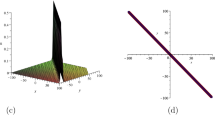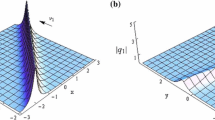Abstract
In this work, we constructed the multi-soliton solutions to the Ward equation with the help of the generalized Darboux transformation method. Importantly, we obtained the determinant representation of the Ward multi-soliton solutions with trivial and nontrivial scattering. All calculations indicate that the Darboux transformation method is an effective and straightforward way to generate the Ward solutions. These obtained determinantal solutions are particularly useful for analyzing the dynamical behaviors of the energy density functions of the Ward multi-soliton solutions. By investigating the energy density figures, we illustrated the nontrivial scattering properties of the Ward multi-soliton solutions. These results are meaningful for quantum field theory and could be utilized to provide an intuitive description of the particle interactions.







Similar content being viewed by others
Data availability
All data generated or analyzed during this study are included in this published article.
References
Barone, A., Esposito, F., Magee, C., Scott, A.: Theory and applications of the sine-gordon equation. Riv. Nuovo Cimento 1(2), 227–267 (1971). https://doi.org/10.1007/BF02820622
Schwarz, J.H.: Covariant field equations of chiral n= 2 d= 10 supergravity. Nuclear Phys. B 226(2), 269–288 (1983). https://doi.org/10.1016/0550-3213(83)90192-X
Ward, R.S.: Soliton solutions in an integrable chiral model in 2+1 dimensions. J. Math. Phys. 29(2), 386–389 (1988). https://doi.org/10.1063/1.528078
Ablowitz, M.J., Chakravarty, S., Halburd, R.G.: Integrable systems and reductions of the self-dual Yang–Mills equations. J. Math. Phys. 44(8), 3147–3173 (2003). https://doi.org/10.1063/1.1586967
Bardeen, W.A.: Self-dual Yang–Mills theory, integrability and multiparton amplitudes. Prog. Theor. Phys. Suppl. 123(1), 1–8 (1996). https://doi.org/10.1143/PTPS.123.1
Yang, C.N., Mills, R.L.: Conservation of isotopic spin and isotopic gauge invariance. Phys. Rev. 96(1), 191 (1954). https://doi.org/10.1103/PhysRev.96.191
Hell, A.: The strong couplings of massive Yang–Mills theory. J. High Energy Phys. 2022(3), 1–31 (2022). https://doi.org/10.1007/JHEP03(2022)167
Plansangkate, P.: Compactified twistor fibration and topology of ward unitons. J. Geom. Phys. 104, 1–18 (2016). https://doi.org/10.1016/j.geomphys.2016.01.011
Maas, A., Mufti, T.: Spectroscopic analysis of the phase diagram of Yang–Mills–Higgs theory. Phys. Rev. D 91(11), 113011 (2015). https://doi.org/10.1103/PhysRevD.91.113011
Ward, R.S.: Nontrivial scattering of localized solitons in a (2+1)-dimensional integrable system. Phys. Lett. A 208, 203–208 (1995). https://doi.org/10.1016/0375-9601(95)00782-X
Ward, R.S.: Classical solutions of the chiral model, unitons, and holomorphic vector bundles. Commun. Math. Phys. 128(2), 319–332 (1990). https://doi.org/10.1007/bf02108784
Zhu, X.J.: Holomorphic vector bundles corresponding to some soliton solutions of the ward equation. Math. Phys. Anal. Geom. 18, 1–11 (2015). https://doi.org/10.1007/s11040-015-9192-7
Getmanov, B., Sutcliffe, P.M.: Yang–Mills–Higgs soliton dynamics in 2+ 1 dimensions. Theoret. Math. Phys. 117(3), 1375–1384 (1998). https://doi.org/10.1007/BF02557176
Tafel, J.: Yang–Mills–Higgs equations with nonhomogeneous boundary conditions. Class. Quant. Gravity 14(1A), 335 (1997). https://doi.org/10.1088/0264-9381/14/1A/026
Vachaspati, T.: Construction of non-abelian electric strings. Phys. Rev. D 107(9), 096015 (2023). https://doi.org/10.1103/PhysRevD.107.096015
Ioannidou, T.: Soliton solutions and nontrivial scattering in an integrable chiral model in (2+1) dimensions. J. Math. Phys. 37(7), 3422–3441 (1996). https://doi.org/10.1063/1.531573
Ioannidou, T., Manton, N.: The energy of scattering solitons in the ward model. Proc. Roy. Soc. Sect. A 461(2059), 1965–1973 (2005). https://doi.org/10.1098/rspa.2005.1451
Zakharov, V.E., Mikhailov, A.V.: Example of nontrivial interaction of solitons in twodimensional classical field theory. Pisma Zh. Eksp. Teor. Fiz. 27, 42–46 (1978)
Forgács, P., Horváth, Z., Palla, L.: Solution-generating technique for self-dual monopoles. Nuclear Phys. B 229(1), 77–104 (1983). https://doi.org/10.1016/0550-3213(83)90354-1
Uhlenbeck, K.: Harmonic maps into lie groups: classical solutions of the chiral model. J. Differ. Geom. 30(1), 1–50 (1989). https://doi.org/10.4310/jdg/1214443286
Burstall, F.E., Guest, M.A.: Harmonic two-spheres in compact symmetric spaces, revisited. Math. Ann. 309, 541–572 (1997). https://doi.org/10.1007/s002080050127
Wood, J.C.: Explicit construction and parametrization of harmonic two-spheres in the unitary group. Proc. Lond. Math. Soc. 3(3), 608–624 (1989). https://doi.org/10.1112/plms/s3-58.3.608
Schimming, R., Mundt, E.: Constant potential solutions of the Yang–Mills equation. J. Math. Phys. 33(12), 4250–4254 (1992). https://doi.org/10.1063/1.529825
Sutcliffe, P.: Nontrivial soliton scattering in an integrable chiral model in (2+ 1)-dimensions. J. Math. Phys. 33(6), 2269–2278 (1992). https://doi.org/10.1063/1.529599
Ioannidou, T., Ward, R.S.: Conserved quantities for integrable chiral equations in 2+ 1 dimensions. Phys. Lett. A 208(3), 209–213 (1995). https://doi.org/10.1016/0375-9601(95)00781-W
Anand, C.K.: Ward solitons. Geom. Topol. 1(1), 9–20 (1997). https://doi.org/10.2140/gt.1997.1.9
Anand, C.K.: Ward solitons II: exact solutions. Can. J. Math. 50(6), 1119–1137 (1998). https://doi.org/10.4153/CJM-1998-054-3
Uhlenbeck, K.: On the connection between harmonic maps and the self-dual yang-mills and the Sine–Gordon equations. J. Geom. Phys. 8(1–4), 283–316 (1992). https://doi.org/10.1016/0393-0440(92)90053-4
Villarroel, J.: The inverse problem for Ward’s system. Stud. Appl. Math. 83(3), 211–222 (1990). https://doi.org/10.1002/sapm1990833211
Fokas, A.S., Ioannidou, T.A.: The inverse problem for the Ward equation and for the (2+1) chiral model. Commun. Appl. Anal. 5, 235 (2001). https://doi.org/10.48550/arXiv.hep-th/9806035
Dai, B., Terng, C.L.: Bäcklund transformations, ward solitons, and unitons. J. Differ.l Geom. 75(1), 57–108 (2007). https://doi.org/10.4310/jdg/1175266254
Dunajski, M., Manton, N.: Reduced dynamics of ward solitons. Nonlinearity 18(4), 1677 (2005). https://doi.org/10.1088/0951-7715/18/4/014
Wu, D.: The Cauchy problem of the ward equation. J. Funct. Anal. 256(1), 215–257 (2009). https://doi.org/10.1063/1.3013120
Benincasa, G.B., Halburd, R.: Bianchi permutability for the anti-self-dual Yang–Mills equations. Stud. Appl. Math. 137(1), 110–122 (2016). https://doi.org/10.1111/sapm.12118
Huang, S.C.: On soliton solutions of the anti-self-dual yang-mills equations from the perspective of integrable systems (2021). arXiv preprint arXiv:2112.10702
Li, S.S., Qu, C.Z., Yi, X.X., Zhang, D.J.: Cauchy matrix approach to the SU (2) self-dual Yang–Mills equation. Stud. Appl. Math. 148(4), 1703–1721 (2022). https://doi.org/10.1111/sapm.12488
Gilson, C.R., Hamanaka, M., Huang, S.C., Nimmo, J.C.: Soliton solutions of noncommutative anti-self-dual Yang–Mills equations. J. Phys. A 53(40), 404002 (2020). https://doi.org/10.1088/1751-8121/aba72e
Hamanaka, M., Huang, S.C.: New soliton solutions of anti-self-dual Yang–Mills equations. J. High Energy Phys. 2020(10), 1–18 (2020). https://doi.org/10.1007/jhep10(2020)101
Hamanaka, M., Huang, S.C.: Multi-soliton dynamics of anti-self-dual gauge fields. J. High Energy Phys. 2022(1), 1–19 (2022). https://doi.org/10.1007/jhep01(2022)039
Stalin, S., Senthilvelan, M., Lakshmanan, M.: Energy-sharing collisions and the dynamics of degenerate solitons in the nonlocal Manakov system. Nonlinear Dyn. 95, 1767–1780 (2019). https://doi.org/10.1007/s11071-018-4658-3
Wang, M.M., Chen, Y.: Dynamic behaviors of general n-solitons for the nonlocal generalized nonlinear Schrödinger equation. Nonlinear Dyn. 104(3), 2621–2638 (2021). https://doi.org/10.1007/s11071-021-06421-3
Iqbal, M., Seadawy, A.R., Lu, D.C., Zhang, Z.D.: Structure of analytical and symbolic computational approach of multiple solitary wave solutions for nonlinear Zakharov–Kuznetsov modified equal width equation. Numer. Methods Part. Differ. Equ. (2023). https://doi.org/10.1002/num.23033
Seadawy, A.R., Iqbal, M., Lu, D.C.: Propagation of kink and anti-kink wave solitons for the nonlinear damped modified Korteweg-de Vries equation arising in ion-acoustic wave in an unmagnetized collisional dusty plasma. Physica A 544, 123560 (2020). https://doi.org/10.1016/j.physa.2019.123560
Seadawy, A.R., Iqbal, M.: Propagation of the nonlinear damped Korteweg-de Vries equation in an unmagnetized collisional dusty plasma via analytical mathematical methods. Math. Methods Appl. Sci. 44(1), 737–748 (2021). https://doi.org/10.1002/mma.6782
Gu, C.H., Hu, H.S., Zhou, Z.X.: Darboux Transformation in Soliton Theory and Its Geometric Applications. Shanghai Scientific and Technical Publishers, Shanghai (1999)
Chen, D.Y.: Introduction to Solitons. Science Press, Beijing (2006)
Li, Y.S.: Solitons and Integrable Systems. Shanghai Science and Technology Education Press, Shanghai (1999)
Matveev, V.B., Salle, M.A.: Darboux Transformations and Solitons. Springer, Berlin (1991)
Guo, B.L., Ling, L.M., Liu, Q.P.: Nonlinear Schrödinger equation: generalized darboux transformation and rogue wave solutions. Phys. Rev. E 85(2), 026607 (2012). https://doi.org/10.1103/physreve.85.026607
Ling, L.M., Feng, B.F., Zhu, Z.N.: Multi-soliton, multi-breather and higher order rogue wave solutions to the complex short pulse equation. Physica D 327, 13–29 (2016). https://doi.org/10.1016/j.physd.2016.03.012
Zhang, X.E., Ling, L.M.: Asymptotic analysis of high-order solitons for the Hirota equation. Physica D 426, 132982 (2021). https://doi.org/10.1016/j.physd.2021.132982
Funding
Liming Ling is supported by the National Natural Science Foundation of China (No.12122105).
Author information
Authors and Affiliations
Corresponding author
Ethics declarations
Conflict of interest
The authors declare that they have no conflict of interest with other people or organizations that may inappropriately influence the author’s work.
Additional information
Publisher's Note
Springer Nature remains neutral with regard to jurisdictional claims in published maps and institutional affiliations.
Appendices
Appendix A. Proof of Theorem 1
Proof
According to the Lax pair of the Ward equation, we can obtain that \(\textbf{U}=\left[ (\lambda \partial _x-\partial _u) {\pmb \Psi }\right] {\pmb \Psi }^{-1}\). Assuming that \(\textbf{U}\) is independent of \(\lambda \). Set the Darboux transformation as \({\pmb \Psi }_{1}=\textbf{T}_1{\pmb \Psi }\), we hope that \({\pmb \Psi }_{1}\) satisfies the same equation as system (5). Based on the system (5), we have \(\textbf{T}_1[(\lambda \partial _x-\partial _u) {\pmb \Psi }]=\textbf{T}_1\textbf{U}{\pmb \Psi }\), which can be used to derive the following formulas
Take \(\textbf{U}_1=\textbf{T}_1\textbf{U}{} \textbf{T}_1^{-1}+(\lambda \partial _x \textbf{T}_{1}-\partial _u \textbf{T}_{1})\textbf{T}_1^{-1}\), then \({\pmb \Psi }_{1}\) and \(\textbf{U}_1\) satisfy the new system (11). Next, we need to prove that \(\textbf{U}_1\) is independent of \(\lambda \).
According to the form of \(\textbf{T}_1\) and \(\textbf{T}_1^{-1}\), we know that \(\textbf{U}_1\) may have singularities at \(\lambda ={\lambda _1}^*\) and \(\lambda ={\lambda _1}\), the residue of \(\textbf{U}_1\) at \(\lambda =\lambda _1\) and \(\lambda ={\lambda _1}^*\) should be 0, which is equivalent to
Then we consider the asymptotics as \(\lambda \rightarrow \infty \). Since \(\textbf{U}\) is independent of \(\lambda \), we get \(\textbf{T}_1\textbf{U}{} \textbf{T}_1^{-1}\) is independent of \(\lambda \). For \(\lambda \rightarrow \infty \), by taking the limit of \((\lambda \partial _x \textbf{T}_{1}-\partial _u \textbf{T}_{1})\textbf{T}_1^{-1}\), we obtain that \({\textbf{U}}_1={\mathcal {O}}(\lambda ^{-1})\) as \(\lambda \rightarrow \infty \). So \(\textbf{U}_1\) is holomorphic at \(\lambda \in {\mathbb {C}} \cup \lbrace \infty \rbrace \). By Liouville theorem, we can get \(\textbf{U}_1\) is independent of \(\lambda \). Similarly, we can prove that \(\textbf{V}_1=(\lambda \partial _v \textbf{T}_{1}-\partial _x \textbf{T}_{1})\textbf{T}_1^{-1}+\textbf{T}_1\textbf{V}{} \textbf{T}_1^{-1}\) is independent of \(\lambda \).
Finally, since \(\textbf{U},\textbf{V} \in \textbf{u}(n)\), so \(\textbf{U},\textbf{V}\) have the following symmetry,
We need to prove that \(\textbf{U}_1\) and \(\textbf{V}_1\) have the same symmetry as \(\textbf{U}\) and \(\textbf{V}\). For \(\textbf{U}_1=\textbf{T}_1\textbf{U}{} \textbf{T}_1^{-1}+(\lambda \partial _x \textbf{T}_{1}-\partial _u \textbf{T}_{1})\textbf{T}_1^{-1}\), we have
Then we have \(\textbf{U}_1 \in \textbf{u}(n)\). Similarly, we get that \(\textbf{V}_1 \in \textbf{u}(n)\). Therefore, it is proved that \(\textbf{U}_1, \textbf{V}_1\) share the same form and properties with \(\textbf{U}, \textbf{V}\), respectively. Hence, we verify that Darboux transformation \({\pmb \Psi }_{1}=\textbf{T}_1{\pmb \Psi }\) is a gauge transformation that can be used to construct exact solutions. \(\square \)
Appendix B. Proof of Theorem 2
Proof
According to the Theorem 1, we can write the n-fold Darboux matrix as:
It is obvious that \(\textbf{T}^{[n]}(x,y,t;\lambda )\) has singularities at \(\lambda ={\lambda _i}^*\), so \(\textbf{T}^{[n]}(x,y,t;\lambda )\) can be rewritten as the following form,
where rank\((\textbf{A}_i(x,y,t))=1\) which can be derived from the Theorem 1. Then we can assume \(\textbf{A}_i(x,y,t)= |\textbf{x}_i\rangle \langle \textbf{y}_i|\), where \( |\textbf{x}_i\rangle \) is a column vector, \( \langle \textbf{y}_i|\) is a row vector.
Considering the \(\textbf{U}(n)\)-real condition \( \textbf{T}^{[n]}(x,y,t;\lambda )[\textbf{T}^{[n]}(x,y,t;{\lambda }^*)]^{\dagger }={\mathbb {I}} \) and its Taylor expansion at \(\lambda =\lambda _j\), then we obtain
Based on Ker\((\textbf{T}^{[n]}(x,y,t;\lambda _j))={\pmb \Psi }(x,y,t; \lambda _j)\textbf{q}_{j}\), then we get
which can be represented as the matrix form:
where \(\textbf{M}=\left( \frac{\left\langle \textbf{y}_i \mid \textbf{y}_j\right\rangle }{\lambda _i^*-\lambda _j}\right) _{1 \le i, j \le n}.\) Therefore, we have
where \(\textbf{D}={\text {diag}}\left( \lambda -{\lambda _1}^*, \lambda -{\lambda _2}^*, \cdots , \lambda -{\lambda _n}^*\right) \), \(\textbf{Y}=\left[ \left| \textbf{y}_1\right\rangle , \left| \textbf{y}_2\right\rangle , \cdots , \left| \textbf{y}_n\right\rangle \right] .\) \(\square \)
Rights and permissions
Springer Nature or its licensor (e.g. a society or other partner) holds exclusive rights to this article under a publishing agreement with the author(s) or other rightsholder(s); author self-archiving of the accepted manuscript version of this article is solely governed by the terms of such publishing agreement and applicable law.
About this article
Cite this article
Ling, L., Yang, H. The determinant representation of Ward soliton solutions and its dynamical behaviors. Nonlinear Dyn 112, 7417–7432 (2024). https://doi.org/10.1007/s11071-024-09453-7
Received:
Accepted:
Published:
Issue Date:
DOI: https://doi.org/10.1007/s11071-024-09453-7




